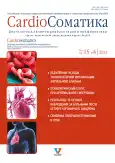Assessment of long-term changes in subvalvular aortic stenosis in patients following transcatheter aortic valve implantation
- Authors: Bazylev V.V.1,2, Voevodin A.B.1,2, Masyutin A.S.1
-
Affiliations:
- Federal Center for Cardiovascular Surgery
- Penza State University
- Issue: Vol 15, No 4 (2024)
- Pages: 299-306
- Section: Original study articles
- URL: https://journal-vniispk.ru/2221-7185/article/view/281640
- DOI: https://doi.org/10.17816/CS635665
- ID: 281640
Cite item
Full Text
Abstract
BACKGROUND: The clinical course, pathophysiology, and therapeutic options for valvular and subvalvular (accompanied by hypertrophic cardiomyopathy, HCM) aortic stenosis are well known separately, but the rare combination of severe aortic stenosis (AS) and obstructive HCM presents great diagnostic and treatment challenges. The combination of these diseases during transcatheter aortic valve implantation (TAVI) is associated with significantly worse hospital outcomes, including cardiogenic shock, renal failure, and death. There is evidence that TAVI without prior treatment of left ventricular outflow tract obstruction leads to higher mortality due to exacerbation of subvalvular obstruction.
AIM: To evaluate changes in hypertrophy of interventricular septum (IVS) in patients with a combination of AS and HCM following TAVI.
MATERIALS AND METHODS: The observational, retrospective, single-center, non-randomized study included 20 patients with diagnosed severe AS, preoperative IVS thickness ≥15 mm, and the preoperative ratio of IVS and left ventricular posterior wall thickness ≥1.3, following TAVI. Mean and maximum follow-up periods were 33 and 92 months, respectively. The primary endpoint was decreased IVS thickness following TAVI as determined by echocardiography.
RESULTS: The average age of patients was 72.4±5.5 years, more than half of the subjects were women. 60% of patients were diagnosed with coronary artery disease at the time of TAVI. Pre- and postoperative median IVS thicknesses were 17.7±2.2 and 14.4±3.2 mm, respectively. Long-term outcomes of TAVI included a significant decrease in hypertrophy of IVS (p=0.031) IVS thicknesses mainly decreased over the period up to 24 months after surgery. Cox regression analysis found that each year of patient’s age increased the risk of no postoperative decrease in IVS thickness after surgery by 12% every month.
CONCLUSION: There was a statistically significant decrease in hypertrophy of IVS in patients who underwent TAVI. In most cases, IVS thickness decreased within 2 years after surgery. Each year of patient’s age increased the risk of no postoperative decrease in IVS thicknesses by 12% every month.
Full Text
##article.viewOnOriginalSite##About the authors
Vladlen V. Bazylev
Federal Center for Cardiovascular Surgery; Penza State University
Author for correspondence.
Email: cardio-penza@yandex.ru
ORCID iD: 0000-0001-6089-9722
SPIN-code: 3153-8026
MD, Dr. Sci. (Medicine), Professor, Medical Institute
Russian Federation, 6 Stasov street, 440071 Penza; 440026 Penza 3/10, Lermontov st.Andrey B. Voevodin
Federal Center for Cardiovascular Surgery; Penza State University
Email: voevodin.ab@gmail.com
ORCID iD: 0000-0002-7078-1274
SPIN-code: 7869-9962
MD, Cand. Sci. (Medicine), Medical Institute
Russian Federation, 6 Stasov street, 440071 Penza; 440026 Penza 3/10, Lermontov st.Alexey S. Masyutin
Federal Center for Cardiovascular Surgery
Email: evgeniam2014@gmail.com
ORCID iD: 0009-0007-9857-5863
Medical Institute
Russian Federation, 6 Stasov street, 440071 PenzaReferences
- Barasch E. Aortic Stenosis Associated with Hypertrophic Cardiomyopathy: A Double Trouble. Cardiology. 2023;148(3):287–288. doi: 10.1159/000530663.
- Bandyopadhyay D, Chakraborty S, Amgai B, et al. Association of Hypertrophic Obstructive Cardiomyopathy With Outcomes Following Transcatheter Aortic Valve Replacement. JAMA Netw Open. 2020;3(2):e1921669. doi: 10.1001/jamanetworkopen.2019.21669
- Zhang Q, Xu Y, Wang H, et al. TAVR for Severe Aortic Valve Stenosis with LVOT Stenosis: A Case Report. Int Med Case Rep J. 2024;17:719–723. doi: 10.2147/IMCRJ.S456154
- Khan A, Tang G, Engstrom K, et al. Aortic Stenosis With Severe Asymmetric Septal Hypertrophy: A Novel Management Strategy to Improve TAVR Outcomes. JACC Cardiovasc Interv. 2019;12(21):2228–2230. doi: 10.1016/j.jcin.2019.06.025
- Hegde S, Lester S, Solomon S, et al. Effect of Mavacamten on Echocardiographic Features in Symptomatic Patients With Obstructive Hypertrophic Cardiomyopathy. J Am Coll Cardiol. 2021;78(25):2518–2532. doi: 10.1016/j.jacc.2021.09.1381
- Olsen K, LaGrew J, Awoniyi C, Goldstein J. Undiagnosed hypertrophic obstructive cardiomyopathy during transcatheter aortic valve replacement: a case report. J Med Case Rep. 2018;12(1):372. doi: 10.1186/s13256-018-1904-8
- Krishnaswamy A, Tuzcu E, Svensson L, Kapadia S. Combined transcatheter aortic valve replacement and emergent alcohol septal ablation. Circulation. 2013;128(18):e366-8. doi: 10.1161/CIRCULATIONAHA.112.000470
- Chang S, Nagueh S, Spencer W 3rd, Lakkis NM. Complete heart block: determinants and clinical impact in patients with hypertrophic obstructive cardiomyopathy undergoing nonsurgical septal reduction therapy. J Am Coll Cardiol. 2003;42(2):296–300. doi: 10.1016/s0735-1097(03)00623-5
- Bansal P, Lodhi H, Mathews A, et al. Haemodynamic Interplay Between Concomitant Left Ventricular Outflow Tract Obstruction and Aortic Stenosis. Interv Cardiol. 2021;16(11):e11. doi: 10.15420/icr.2020.36
- Alam M, Dokainish H, Lakkis N. Alcohol septal ablation for hypertrophic obstructive cardiomyopathy: a systematic review of published studies. J Interv Cardiol. 2006;19(4):319–327. doi: 10.1111/j.1540-8183.2006.00153.x
- Kashtanov MG, Idov EM. Historical and modern aspects of diagnosis and treatment of obstructive hypertrophic cardiomyopathy: a literature review. Pathology of blood circulation and cardiac surgery. 2016;20(1):47–55. EDN: VVAMWN doi: 10.21688/1681-3472-2016-1-47-55 3
- Shayakhmetova SV, Afanasyev AV, Bogachev-Prokofiev AV. Cardiac magnetic resonance imaging in obstructive hypertrophic cardiomyopathy: scanning, visualization, and some aspects of clinical significance (a literature review with our own clinical observations). Radiology – practice. 2021;86(2):72–86. EDN: XUPBKU doi: 10.52560/2713-0118-2021-2-72-86
- Reznik EV, Nguyen TL, Dikaeva MS, et al. Features of the diagnosis and course of hypertrophic cardiopyopathy in real clinical practice. Archives of Internal Medicine. 2023;13(3):181–195. EDN: GGLHPG doi: 10.20514/2226-6704-2023-13-3-181-195
- Nikolaeva IE, Plechev VV, Mukhametyanov AM, et al. Alcohol septal ablation for hypertrophic cardiomyopathy with left ventricular outflow tract obstruction under the control of contrast echocardiography. Creative surgery and oncology. 2019;9(2):132–137. EDN: YRVOKU doi: 10.24060/2076-3093-2019-9-2-132-137
Supplementary files












